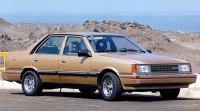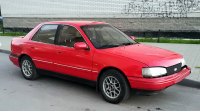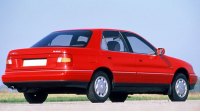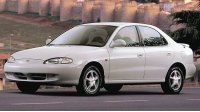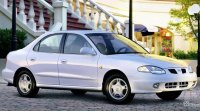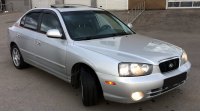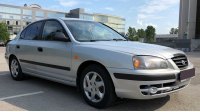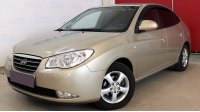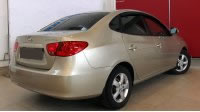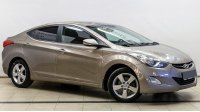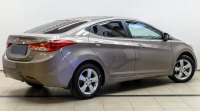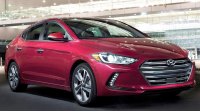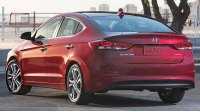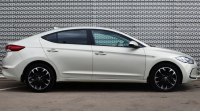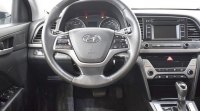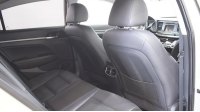The car has a classic engine layout for this class - front transverse with front-wheel drive. The engines were mainly economical 4-cylinder in-line engines. The body was made in the form of a sedan and a hatchback. For all time, six generations of Elantra have been released. The main competitors at the time of appearance were Ford Sierra, Citroen Xantia and Opel Vectra, currently it is a Citroen C4, Chevrolet Cruze, Ford Focus, Honda Civic, Mazda 3, Mitsubishi Lancer, Renault Fluence, Peugeot 301, Kia ceed, Lada Vesta, Opel Astra, Nissan Almera, SEAT Leon, Skoda Octavia, Suzuki Liana, Toyota Corolla and Toyota Auris.
First generation (J1, 1990—1995)
First code-named cars «J1» saw the light in October 1990. Assembly shops were located only in South Korea. The body was only in the form of a 4-door sedan. In 1992, 1993 and 1994, the car received a minor facelift that affected the exterior and added options such as ABS, airbags, fog lights, and electric side mirrors.
The engines of the first generation of cars were only gasoline 4-cylinder in-line cylinders with a volume of 1.5, 1.6 and 1.8 liters with a capacity of 113 to 124 hp. Since Hyundai did not yet produce its engines at that time, they first installed 8-valve Mitsubishi engines, and later began to produce 16-valve engines under Mitsubishi license. There were two transmissions - a 5-speed manual or a 4-speed automatic.
Second generation (J2, 1995—2000)
In 1995, the production of the next generation Elantra with the code name «J2» or «RD». The outer lines of the car have become more rounded, the interior is also made with a minimum number of corners. The bumpers are painted to match the body color. The body was originally a 4-door sedan, and a year and a half later a 5-door station wagon appeared. Assembly facilities were located in Korea, Botswana and Indonesia.
Brakes front disc, rear drum or disc. Steering rack and pinion with hydraulic booster. Suspension independent McPherson type.
The line of engines looked as follows. Gasoline volumes of 1.5, 1.6, 1.8 and 2.0 liters with a capacity of 82 to 139 hp, all 4-cylinder rows. Also in 1998, a 1.9-liter naturally aspirated diesel engine with a capacity of 68 hp appeared. Transmission 4-speed automatic or 5-speed manual.
In 1998, there was a small update of the second generation, which received the codes «J3» And «RD2». Changed the shape of the headlights, lanterns and bumpers, and added molding on the side.
Third generation (XD, 2000—2006)
This generation was presented to the public in 2000 under the code «XD». The station wagon body was replaced by a 5-door hatchback, and the traditional 4-door sedan also remained. Two trim levels - «GLS» (standard) And «GT» (more expensive finishes and additional options). Standard equipment includes front airbags, air conditioning, central locking, power windows and power steering. Production facilities were located in Iran, Korea, China, Malaysia, Russia, Taiwan and Ukraine.
There were three petrol engines - with a volume of 1.6, 1.8 and 2.0 liters with power from 103 to 140 hp. (Beta II, 4-cylinder, in-line). One 2.0 liter diesel engine with 112 hp. (D series, 4-cylinder, in-line, turbocharged). There are two transmissions to choose from - a 5-speed manual and a 4-speed automatic.
In 2003, the car was facelifted and given a code «XD2». Changed the design of external lighting devices, grille, both bumpers, trunk, hood and dashboard.
Fourth generation (HD, 2007—2010)
Elantra IV was introduced at the New York International Auto Show in April 2006 (HD code), and at the end of this year, official sales began. According to the American organization «Insurance Institute for Highway Safety» (IIHS) the car received a good overall score in the frontal crash and a marginal overall score in the side crash. After November 2009, Hyundai improved and received a good overall score in a side impact.
The engine range included two 1.6 petrol (Gamma) and 2.0 (Beta II) liters with a capacity of 122 and 143 hp (4-cylinder in-line), as well as one 1.6-liter diesel engine with a capacity of 115 hp. (U-Line, 4-cylinder in-line, turbocharged). The gearbox is traditionally a 4-speed automatic or 5-speed manual.
Fifth generation (MD/UD, 2011—2015)
This generation of Elantra was introduced in May 2010 at the Busan International Auto Show. The car went on sale in August 2010 as the 2011 model year. The codename was «MD», for the USA the code was «UD». The body was in the form of a 4-door sedan and a small part of a 2-door coupe with the code «JK». Assembly shops were located in Algeria, India, Korea, China, USA, Russia and Taiwan.
In 2012 Elantra received an award «North American Car of the Year» at the Detroit Auto Show ahead of Ford Focus and Volkswagen Passat. In 2014, a rather strong restyling of the car was carried out.
The engine range is represented by 1.6 petrol (Gamma) and 1.8 liters (Nu) 132 and 150 hp, all 4-cylinder in-line, Nu engine block made of aluminum instead of cast iron. Two-liter engines were installed on cars with a coupe body. The diesel engine was one 1.6 liter (CRDi) 115 hp There are two transmissions - 6-speed automatic or manual.
The car has become even more economical thanks to modern engines and a low air resistance coefficient of 0.28.
Sixth generation (AD, 2016—present)
In February 2016, the sixth generation, codenamed «AD» like 2017 model. The body is produced only as a 4-door sedan. The design has become more conservative, the appearance has become like a fastback (sloped back). There are two types of trim - SE and Limited. For 2017, under-steering wheel audio control became standard on all trim levels. Assembly shops are located in India, Iran, China, Korea, Russia, USA and Taiwan.
The range of gasoline engines has expanded and includes volumes (models) 1.4 (Kappa, turbocharged), 1.6 (Gamma), 1.6 (Gamma G4FJ) and 2.0 (Nu) liters with a capacity of 128 to 154 hp, all 4-cylinder inline. Diesel engine one 1.6 liter (U2, turbocharged) 134 hp Gearboxes three options - 6-speed automatic or mechanics, as well as a 7-speed automatic with two clutches (DCT).

